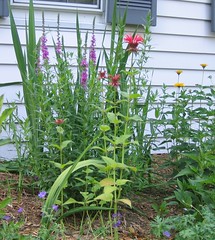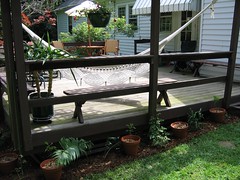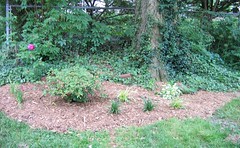Neighbor Tim
Oh, neighbor Tim, how do I love thee? Let me count the ways…
1. When we first moved in, you brought us a welcome gift of brown bread you had baked yourself.
2. You let me borrow your tools. Even though I bend and break them.
3. When you see me working in the yard, you offer to help. I feared for your life when you climbed our rickety ladder and one-handedly chain-sawed limbs from our trees, but I appreciated your generous spirit.
4. When I describe my inside renovation projects, you, once again, offer to help.
 5. You have a wildflower garden in your back yard. You give me tours and name all the unfamiliar plants for me, common name, family, genus, and species.
5. You have a wildflower garden in your back yard. You give me tours and name all the unfamiliar plants for me, common name, family, genus, and species.
6. Most amazingly of all, you offer me wildflowers from your collection. You hand me a shovel, point out the gifted plants, and let me go to town. My yard loves you too.
(Red bloom is Bee Balm [also known as Monarda or Bergamot] from Tim)
Mike is worried that I will run away with you to your Kentucky oasis of lady slipper orchids and limestone caves. While you and I have much in common, he has no need to worry. I am content to have you as my favorite neighbor. Thanks for everything! I’m so glad you live across the street.
1. When we first moved in, you brought us a welcome gift of brown bread you had baked yourself.
2. You let me borrow your tools. Even though I bend and break them.
3. When you see me working in the yard, you offer to help. I feared for your life when you climbed our rickety ladder and one-handedly chain-sawed limbs from our trees, but I appreciated your generous spirit.
4. When I describe my inside renovation projects, you, once again, offer to help.
 5. You have a wildflower garden in your back yard. You give me tours and name all the unfamiliar plants for me, common name, family, genus, and species.
5. You have a wildflower garden in your back yard. You give me tours and name all the unfamiliar plants for me, common name, family, genus, and species.6. Most amazingly of all, you offer me wildflowers from your collection. You hand me a shovel, point out the gifted plants, and let me go to town. My yard loves you too.
(Red bloom is Bee Balm [also known as Monarda or Bergamot] from Tim)
Mike is worried that I will run away with you to your Kentucky oasis of lady slipper orchids and limestone caves. While you and I have much in common, he has no need to worry. I am content to have you as my favorite neighbor. Thanks for everything! I’m so glad you live across the street.

















